the differences of education Between China and the United States
- 格式:ppt
- 大小:2.59 MB
- 文档页数:16
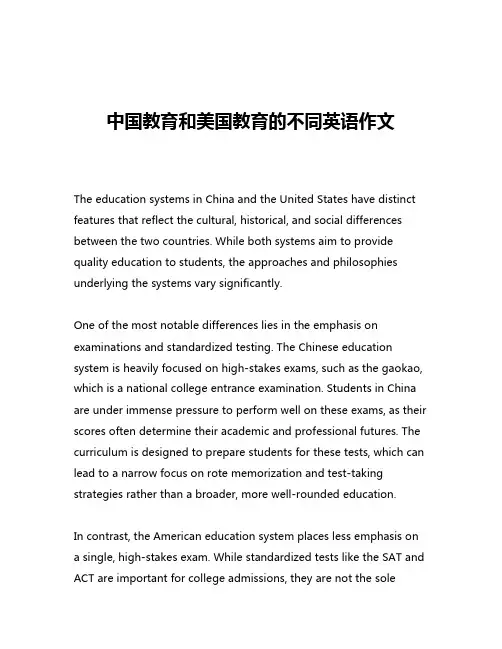
中国教育和美国教育的不同英语作文The education systems in China and the United States have distinct features that reflect the cultural, historical, and social differences between the two countries. While both systems aim to provide quality education to students, the approaches and philosophies underlying the systems vary significantly.One of the most notable differences lies in the emphasis on examinations and standardized testing. The Chinese education system is heavily focused on high-stakes exams, such as the gaokao, which is a national college entrance examination. Students in China are under immense pressure to perform well on these exams, as their scores often determine their academic and professional futures. The curriculum is designed to prepare students for these tests, which can lead to a narrow focus on rote memorization and test-taking strategies rather than a broader, more well-rounded education.In contrast, the American education system places less emphasis on a single, high-stakes exam. While standardized tests like the SAT and ACT are important for college admissions, they are not the soledeterminant of a student's academic success. The curriculum in the United States is generally more diverse, with a greater emphasis on critical thinking, problem-solving, and the development of a wide range of skills and knowledge.Another key difference lies in the role of the teacher. In the Chinese education system, teachers are often seen as authoritative figures who impart knowledge to students. The teacher-student relationship is more formal, and students are expected to respect and obey their teachers. Classroom instruction is typically teacher-centered, with the teacher delivering lectures and students taking notes.On the other hand, the American education system places a greater emphasis on student-centered learning. Teachers are more facilitators of learning, guiding students to discover and construct knowledge for themselves. Classroom activities often involve group discussions, project-based learning, and hands-on activities that encourage students to engage actively with the material.The level of parental involvement in education also differs between the two countries. In China, parents play a crucial role in their children's education, often closely monitoring their academic progress and providing extensive support and guidance. Parental pressure to excel academically is a significant factor in the Chinese education system.In the United States, while parental involvement is encouraged, the level of involvement tends to be more varied. Some parents are heavily involved in their children's education, while others take a more hands-off approach. The American education system also places a greater emphasis on the development of well-rounded individuals, with extracurricular activities and community involvement playing a more significant role.One area where the Chinese and American education systems share some similarities is the increasing focus on STEM (Science, Technology, Engineering, and Mathematics) education. Both countries recognize the importance of developing a strong foundation in these fields to prepare students for the demands of the 21st-century workforce. However, the approaches to STEM education may differ, with the Chinese system placing a greater emphasis on rote learning and mastery of technical skills, while the American system encourages more interdisciplinary and problem-based learning.Despite these differences, both the Chinese and American education systems have their strengths and weaknesses. The Chinese system's emphasis on academic rigor and discipline has produced many high-achieving students, but it has also been criticized for its narrow focus and the immense pressure it places on students. The Americansystem's emphasis on well-rounded education and student-centered learning has produced creative and critical thinkers, but it has also been criticized for a perceived lack of academic rigor.As the world becomes increasingly globalized, there is a growing recognition of the need for a more balanced and integrated approach to education. Both China and the United States can learn from each other's successes and shortcomings, and work towards developing education systems that nurture the holistic development of students while also preparing them for the challenges of the modern world.。
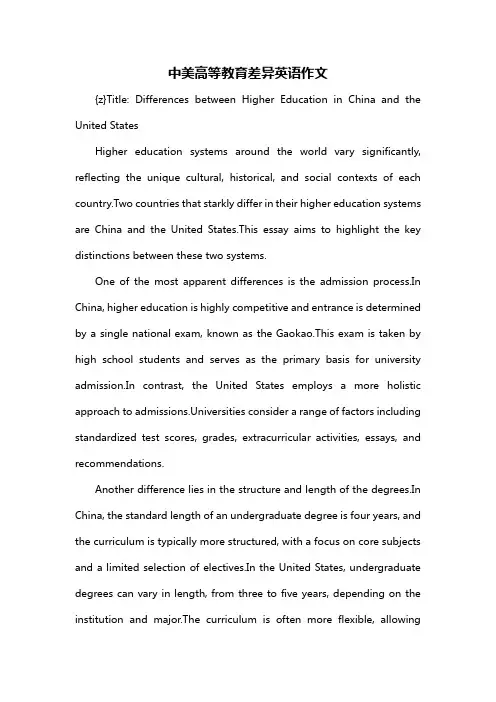
中美高等教育差异英语作文{z}Title: Differences between Higher Education in China and the United StatesHigher education systems around the world vary significantly, reflecting the unique cultural, historical, and social contexts of each country.Two countries that starkly differ in their higher education systems are China and the United States.This essay aims to highlight the key distinctions between these two systems.One of the most apparent differences is the admission process.In China, higher education is highly competitive and entrance is determined by a single national exam, known as the Gaokao.This exam is taken by high school students and serves as the primary basis for university admission.In contrast, the United States employs a more holistic approach to admissions.Universities consider a range of factors including standardized test scores, grades, extracurricular activities, essays, and recommendations.Another difference lies in the structure and length of the degrees.In China, the standard length of an undergraduate degree is four years, and the curriculum is typically more structured, with a focus on core subjects and a limited selection of electives.In the United States, undergraduate degrees can vary in length, from three to five years, depending on the institution and major.The curriculum is often more flexible, allowingstudents to take a broader range of courses outside their major.Furthermore, the concept of academic freedom is more pronounced in the American higher education system.In China, universities often align with government policies and priorities, and there is greater control and regulation over academic content and research.In the United States, universities enjoy more autonomy, encouraging open debate, diverse viewpoints, and innovative research.Moreover, funding and tuition differ significantly.In China, public universities are largely funded by the government, and tuition fees are relatively low.This makes higher education more accessible to a wider range of students.In contrast, tuition fees at American public universities vary by state, but they are generally higher than in China.However, private universities in the United States often offer more financial aid and scholarships, making education more accessible.Lastly, the emphasis on practical experience and internships also differs.Chinese universities often prioritize theoretical knowledge and academic research, with less emphasis on practical experience.In contrast, the American higher education system places a strong emphasis on experiential learning, internships, and practical skills, preparing students better for the job market.In conclusion, there are significant differences between higher education systems in China and the United States.These differencesreflect the unique cultural, historical, and social contexts of each country.Understanding these distinctions can help students make informed decisions about where to pursue their higher education aspirations.。
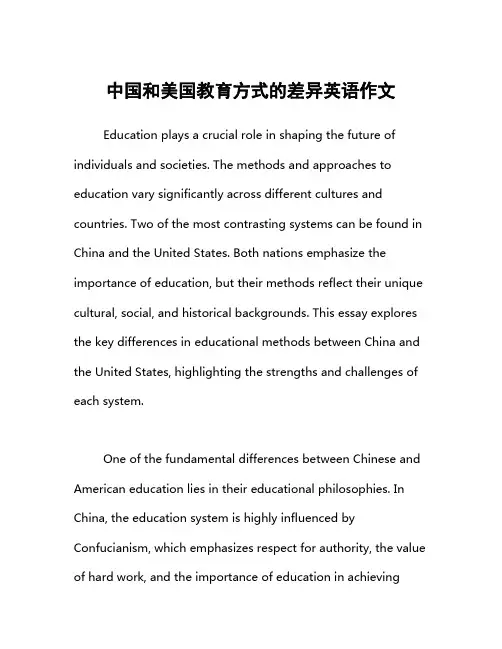
中国和美国教育方式的差异英语作文Education plays a crucial role in shaping the future of individuals and societies. The methods and approaches to education vary significantly across different cultures and countries. Two of the most contrasting systems can be found in China and the United States. Both nations emphasize the importance of education, but their methods reflect their unique cultural, social, and historical backgrounds. This essay explores the key differences in educational methods between China and the United States, highlighting the strengths and challenges of each system.One of the fundamental differences between Chinese and American education lies in their educational philosophies. In China, the education system is highly influenced by Confucianism, which emphasizes respect for authority, the value of hard work, and the importance of education in achievingsocietal harmony and individual success. As a result, Chinese education tends to be more rigid, hierarchical, and exam-oriented. The primary objective is to impart knowledge and skills that will enable students to excel academically and contribute to society.In contrast, the American education system is shaped by the principles of individualism, critical thinking, and creativity. The focus is on developing well-rounded individuals who can think independently, solve problems, and innovate. Education in the United States aims to foster personal growth, self-expression, and the ability to adapt to a rapidly changing world. This difference in philosophy leads to varying approaches to teaching and learning in the two countries.The curriculum in China is highly standardized and centralized. The Ministry of Education dictates the content and structure of the curriculum, which ensures uniformity across the country. Students in China follow a rigorous and demandingschedule, with a strong emphasis on core subjects such as mathematics, science, and Chinese language. Memorization and rote learning are common practices, as students are often required to recall vast amounts of information for exams. The high-stakes nature of these exams, particularly the Gaokao (college entrance examination), puts immense pressure on students to perform well.In contrast, the American curriculum is more flexible and decentralized. While there are national standards and guidelines, local school districts have significant autonomy in designing their curricula. This allows for a more diverse range of subjects and extracurricular activities, catering to the varied interests and talents of students. American education places a strong emphasis on critical thinking, problem-solving, and hands-on learning. Project-based learning, group discussions, and interactive activities are common in American classrooms, fostering an environment where students can explore their interests and develop practical skills.Chinese classrooms are typically characterized by a teacher-centered approach. Teachers are viewed as authoritative figures who impart knowledge to students, who are expected to listen, take notes, and memorize the information. The classroom environment is generally formal and disciplined, with a focus on maintaining order and respect for the teacher. This approach can lead to a deep understanding of core subjects but may limit opportunities for creative expression and critical thinking.In the United States, the classroom environment is often more relaxed and student-centered. Teachers act as facilitators who guide and support students in their learning journey. There is a strong emphasis on interactive and participatory learning, where students are encouraged to ask questions, express their opinions, and engage in discussions. Group work and collaborative projects are common, promoting teamwork and communication skills. This approach nurtures creativity andindependent thinking but may sometimes lead to less emphasis on mastering core academic content.Assessment methods in China are heavily focused on exams and standardized testing. Students’ performance is primarily evaluated based on their ability to recall and apply knowledge in written tests. The Gaokao is the most critical exam in a Chinese student’s academic career, as it determines their eligibility for higher education and future career prospects. The intense focus on exams can lead to a highly competitive environment, where students are motivated to achieve high scores but may experience significant stress and pressure.In the United States, assessment is more varied and holistic. While standardized tests are still important, they are complemented by other forms of evaluation, such as assignments, projects, presentations, and class participation. This approach aims to provide a more comprehensive picture of a student’s abilities and achievements. Continuous assessmentand formative feedback help students identify their strengths and areas for improvement, fostering a growth mindset and encouraging lifelong learning.Parental involvement is another area where Chinese and American education systems differ significantly. In China, parents p lay a crucial role in their children’s education, often taking a hands-on approach to ensure academic success. They may hire tutors, supervise homework, and set high expectations for their children’s performance. This strong support system can drive students to excel but may also contribute to increased pressure and anxiety.In the United States, parental involvement varies widely but generally emphasizes supporting children’s overall development and well-being. Parents are encouraged to participate in school activities, communicate with teachers, and support their children’s interests and aspirations. The focus is on creating a balanced environment where academicachievement is valued but not at the expense of personal growth and happiness.In conclusion, the educational methods in China and the United States reflect their distinct cultural values and societal goals. While the Chinese system emphasizes discipline, hard work, and academic excellence, the American system prioritizes creativity, critical thinking, and holistic development. Both approaches have their strengths and challenges, and there is much that each country can learn from the other. By understanding and appreciating these differences, educators and policymakers can work towards creating more effective and inclusive education systems that prepare students for the demands of the globalized world.。
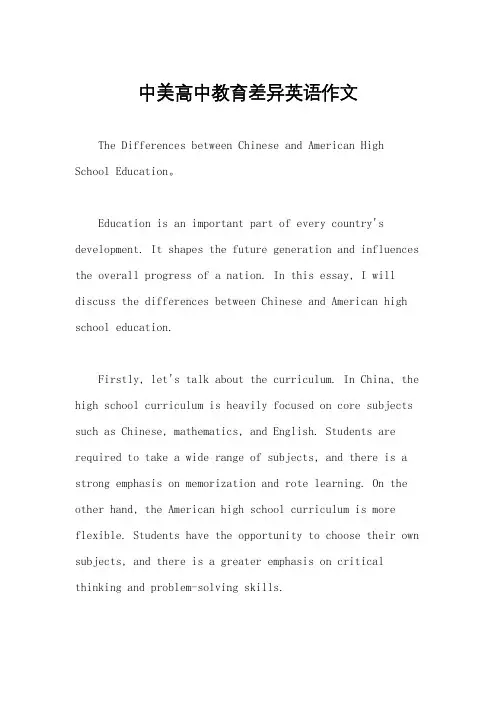
中美高中教育差异英语作文The Differences between Chinese and American High School Education。
Education is an important part of every country's development. It shapes the future generation and influences the overall progress of a nation. In this essay, I will discuss the differences between Chinese and American high school education.Firstly, let's talk about the curriculum. In China, the high school curriculum is heavily focused on core subjects such as Chinese, mathematics, and English. Students are required to take a wide range of subjects, and there is a strong emphasis on memorization and rote learning. On the other hand, the American high school curriculum is more flexible. Students have the opportunity to choose their own subjects, and there is a greater emphasis on critical thinking and problem-solving skills.Secondly, the teaching style is also different. In China, teachers are seen as authority figures, and students are expected to listen and follow instructions. The classroom environment is often very formal, and there is little room for discussion or debate. In contrast, American high school classrooms are more interactive. Teachers encourage students to ask questions and express their opinions, and there is a greater focus on group work and collaborative learning.Another key difference is the assessment system. In China, students are evaluated based on standardized tests, and there is a strong emphasis on academic achievement. This can create a lot of pressure for students, as their entire future may depend on their performance in these exams. In the US, assessment is more holistic. Students are evaluated based on a combination of tests, projects, and class participation, and there is a greater focus on personal development and growth.Furthermore, extracurricular activities play adifferent role in the two systems. In China,extracurricular activities are often seen as a distraction from academic studies, and there is less emphasis on developing skills outside of the classroom. In the US, extracurricular activities are an important part of the high school experience. Students are encouraged to participate in sports, music, drama, and other activities, and there is a greater focus on developing well-rounded individuals.Finally, let's talk about the overall goal of high school education. In China, the main goal of high school education is to prepare students for the Gaokao, the national college entrance examination. Success in this exam is seen as the key to a bright future, and there is a strong focus on academic achievement. In the US, the goal of high school education is to prepare students for college and beyond. There is a greater emphasis on developing critical thinking, creativity, and communication skills, and the focus is on preparing students for a successful and fulfilling life.In conclusion, there are many differences betweenChinese and American high school education. These differences reflect the broader cultural and societal values of each country, and they have a significant impact on the development and future success of students. It is important to recognize and understand these differences in order to create an education system that best serves the needs of our future generation.。
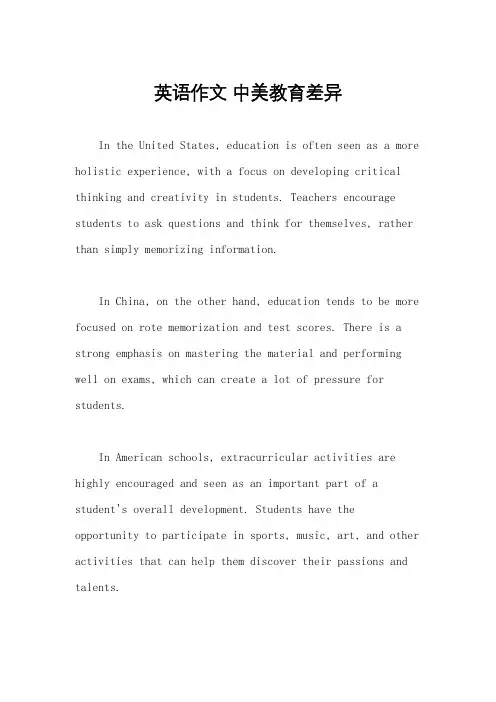
英语作文中美教育差异In the United States, education is often seen as a more holistic experience, with a focus on developing critical thinking and creativity in students. Teachers encourage students to ask questions and think for themselves, rather than simply memorizing information.In China, on the other hand, education tends to be more focused on rote memorization and test scores. There is a strong emphasis on mastering the material and performing well on exams, which can create a lot of pressure for students.In American schools, extracurricular activities are highly encouraged and seen as an important part of a student's overall development. Students have the opportunity to participate in sports, music, art, and other activities that can help them discover their passions and talents.In China, extracurricular activities are often seen as a distraction from academic studies and are not given as much importance. Students may spend most of their time studying and preparing for exams, leaving little time for other pursuits.In the United States, there is a greater emphasis on individualism and independence in education. Students are encouraged to express their opinions and think critically, even if it means challenging authority or conventional wisdom.In China, there is more of a focus on conformity and respect for authority in education. Students are expected to follow the rules and defer to their teachers and elders, which can limit their ability to think independently.Overall, the differences in education between the United States and China reflect broader cultural and societal values. While both systems have their strengths and weaknesses, understanding these differences can helpfoster greater cross-cultural understanding and collaboration.。
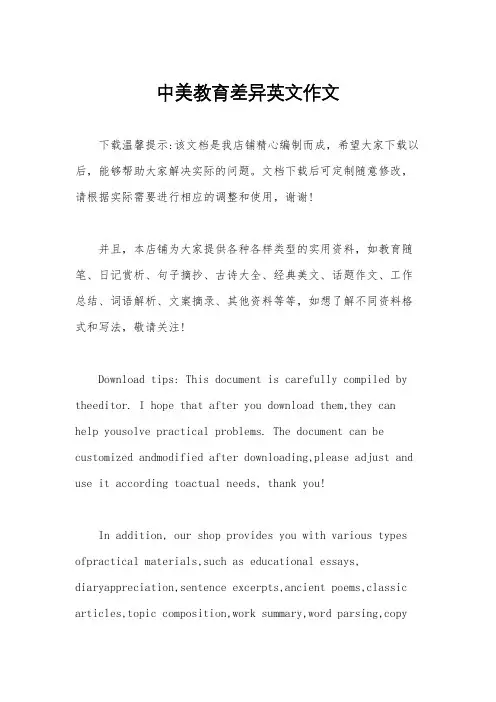
中美教育差异英文作文下载温馨提示:该文档是我店铺精心编制而成,希望大家下载以后,能够帮助大家解决实际的问题。
文档下载后可定制随意修改,请根据实际需要进行相应的调整和使用,谢谢!并且,本店铺为大家提供各种各样类型的实用资料,如教育随笔、日记赏析、句子摘抄、古诗大全、经典美文、话题作文、工作总结、词语解析、文案摘录、其他资料等等,如想了解不同资料格式和写法,敬请关注!Download tips: This document is carefully compiled by theeditor. I hope that after you download them,they can help yousolve practical problems. The document can be customized andmodified after downloading,please adjust and use it according toactual needs, thank you!In addition, our shop provides you with various types ofpractical materials,such as educational essays, diaryappreciation,sentence excerpts,ancient poems,classic articles,topic composition,work summary,word parsing,copyexcerpts,other materials and so on,want to know different data formats andwriting methods,please pay attention!In the US, there's a big focus on individualism in education. Kids are encouraged to think for themselves and express their own opinions.In China, there is more emphasis on discipline and hard work. Students are often pushed to study hard and achieve high grades.In American classrooms, there's a lot of group work and discussions. It's about learning through interaction.In Chinese education, there is a lot of rote learning and memorization. It helps students master a lot of knowledge.In the US, teachers are seen as facilitators. They guide students rather than just giving lectures.In China, teachers are highly respected and have more authority in the classroom.。
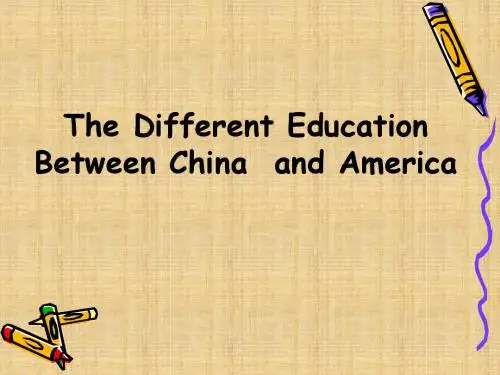
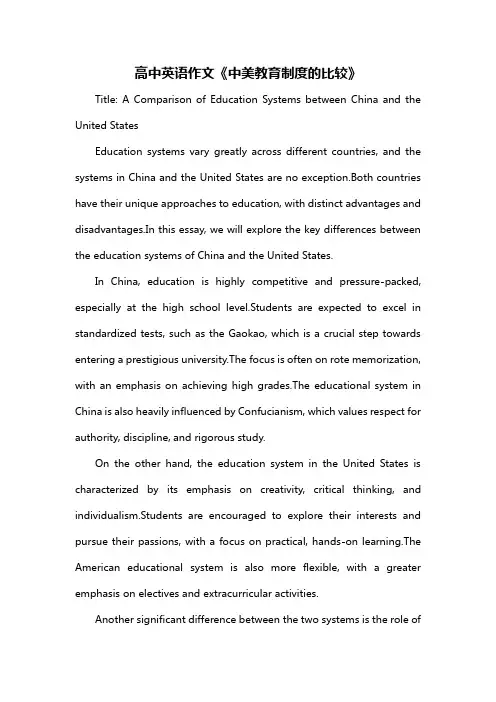
高中英语作文《中美教育制度的比较》Title: A Comparison of Education Systems between China and the United StatesEducation systems vary greatly across different countries, and the systems in China and the United States are no exception.Both countries have their unique approaches to education, with distinct advantages and disadvantages.In this essay, we will explore the key differences between the education systems of China and the United States.In China, education is highly competitive and pressure-packed, especially at the high school level.Students are expected to excel in standardized tests, such as the Gaokao, which is a crucial step towards entering a prestigious university.The focus is often on rote memorization, with an emphasis on achieving high grades.The educational system in China is also heavily influenced by Confucianism, which values respect for authority, discipline, and rigorous study.On the other hand, the education system in the United States is characterized by its emphasis on creativity, critical thinking, and individualism.Students are encouraged to explore their interests and pursue their passions, with a focus on practical, hands-on learning.The American educational system is also more flexible, with a greater emphasis on electives and extracurricular activities.Another significant difference between the two systems is the role ofteachers and parents.In China, teachers hold a position of great respect and authority, and parents often defer to their judgment.In contrast, American teachers are more like facilitators, guiding students in their learning process.Parents play a more active role in their child's education, often collaborating with teachers and schools.Despite these differences, both education systems share a common goal: to provide a quality education that prepares students for the future.However, they differ in their approaches to achieving this goal.The Chinese system emphasizes discipline, hard work, and traditional knowledge, while the American system encourages innovation, critical thinking, and self-expression.In conclusion, the education systems of China and the United States have their unique strengths and weaknesses.While the Chinese system produces high achievers and rigorous learners, the American system fosters creativity, individualism, and practical skills.Ultimately, the best education system is one that prepares students for success in a rapidly changing world, regardless of where it is located.。
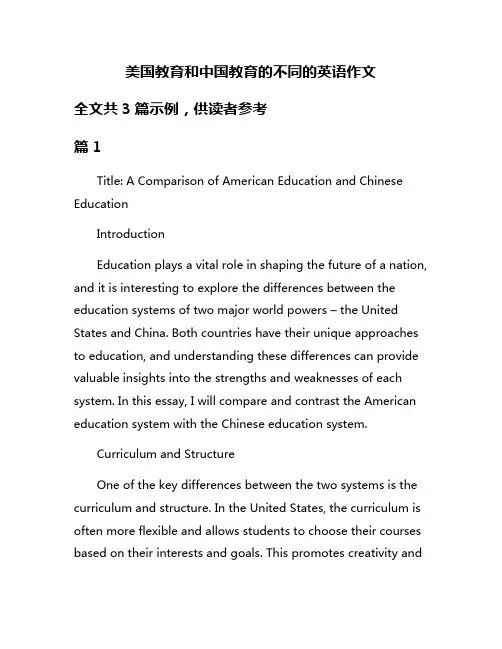
美国教育和中国教育的不同的英语作文全文共3篇示例,供读者参考篇1Title: A Comparison of American Education and Chinese EducationIntroductionEducation plays a vital role in shaping the future of a nation, and it is interesting to explore the differences between the education systems of two major world powers – the United States and China. Both countries have their unique approaches to education, and understanding these differences can provide valuable insights into the strengths and weaknesses of each system. In this essay, I will compare and contrast the American education system with the Chinese education system.Curriculum and StructureOne of the key differences between the two systems is the curriculum and structure. In the United States, the curriculum is often more flexible and allows students to choose their courses based on their interests and goals. This promotes creativity andpersonalized learning, as students have the freedom to explore a wide range of subjects.In contrast, the Chinese education system is more structured and focused on rote learning. Students are required to follow a strict curriculum and memorize large amounts of information for exams. While this approach may lead to high academic achievement, it can limit critical thinking and creativity among students.Standardized TestingStandardized testing is another area where the two systems differ significantly. In the United States, standardized tests such as the SAT and ACT are used as a tool for college admissions. While these tests are important, they are just one of many factors considered in the admissions process.In China, however, standardized testing plays a much larger role in determining a student's academic success. The gaokao, or national college entrance exam, is a high-stakes test that can determine a student's future. Students spend years preparing for this exam, and their scores can have a significant impact on their future opportunities.Teaching MethodsTeaching methods in the two countries also differ. In the United States, the focus is often on student-centered learning, where teachers act as facilitators and guides rather than lecturers. This approach encourages critical thinking and collaboration among students.In China, teaching tends to be more teacher-centered, with an emphasis on authority and respect for teachers. Students are expected to listen and follow instructions, and there is less room for discussion and debate in the classroom.Extracurricular ActivitiesExtracurricular activities are an important part of education in both countries, but they are approached in different ways. In the United States, students are encouraged to participate in a wide range of activities, from sports to music to community service. These activities help students develop leadership skills, teamwork, and social connections.In China, extracurricular activities are often seen as distractions from academic studies. While some schools offer activities such as sports and art clubs, the focus is primarily on academics. This can limit students' opportunities to explore their interests and develop their talents outside of the classroom.ConclusionIn conclusion, the education systems of the United States and China have distinct differences in curriculum, standardized testing, teaching methods, and extracurricular activities. While both systems have their strengths and weaknesses, understanding these differences can provide valuable insights into how each country approaches education and prepares its students for the future. By examining the similarities and differences between the two systems, we can learn from each other and work towards creating a more effective and inclusive education system for all students.篇2Education is an essential part of any country's development, shaping the minds of future generations and preparing them for the challenges of the world. While the ultimate goal of education is universal – to educate and empower individuals – the methods, systems, and priorities can vary greatly between countries. In this essay, we will explore the differences between education in the United States and China.One of the biggest differences between education in the United States and China is the structure of the education system.In the United States, education is decentralized, with each state responsible for its own educational policies and curriculum. This has led to a wide variation in the quality of education between states, with some states consistently ranking higher in educational outcomes than others. On the other hand, China has a centralized education system, with the government setting the curriculum and standards for all schools in the country. This has led to a more standardized education experience for students across China, but has also been criticized for stifling creativity and innovation.Another key difference between education in the United States and China is the focus on standardized testing. In the United States, standardized testing such as the SAT and ACT are used to assess students' academic performance and determine college admissions. While these tests are controversial and have been criticized for promoting rote memorization over critical thinking skills, they are still a key part of the American education system. In China, standardized testing is even more prevalent, with the infamous Gaokao exam determining a student's entire future. The Gaokao is a high-stakes exam that determines which university a student can attend, and has been criticized for putting too much pressure on students and promoting a narrow definition of success.In terms of teaching methods, there are also significant differences between the United States and China. In the United States, there is a greater emphasis on creativity, critical thinking, and student-centered learning. Teachers often use interactive and hands-on teaching methods to engage students and encourage them to think for themselves. In China, on the other hand, the focus is more on rote memorization and traditional teaching methods. Students are expected to memorize large amounts of information and perform well on exams, rather than explore their own interests and passions.Another important difference between education in the United States and China is the role of extracurricular activities. In the United States, extracurricular activities such as sports, arts, and clubs are seen as an important part of a student's education, helping them develop important skills such as teamwork, leadership, and time management. In China, however, extracurricular activities are often seen as a distraction from academic studies, and students are encouraged to focus solely on their schoolwork.In conclusion, while both the United States and China value education as a key part of their national development, there are significant differences in the structure, methods, and priorities oftheir education systems. The United States focuses on creativity, critical thinking, and student-centered learning, while China emphasizes rote memorization, standardized testing, and academic achievement. Both systems have their strengths and weaknesses, and there is much that each country can learn from the other in order to improve the quality of education for all students.篇3Differences Between Education in the United States and ChinaIntroductionEducation plays a crucial role in shaping individuals and societies as a whole. The educational systems in various countries around the world differ in terms of curriculum, teaching methods, assessment methods, and cultural context. In this essay, we will explore the differences between education in the United States and China.CurriculumOne of the primary differences between education in the United States and China is the curriculum. In the United States, the curriculum is more flexible and allows students to choosefrom a wide range of subjects. Students can explore different areas of interest and develop a well-rounded knowledge base. In contrast, the Chinese education system has a more rigid curriculum that focuses heavily on academic subjects such as mathematics, science, and language.Teaching MethodsAnother key difference between education in the United States and China is the teaching methods. In the United States, there is an emphasis on critical thinking, creativity, and independent learning. Teachers often use interactive and collaborative teaching methods to engage students and encourage them to think creatively. On the other hand, the Chinese education system places a greater emphasis on rote learning and memorization. Teachers in China tend to use more traditional teaching methods, such as lectures and drills.Assessment MethodsThe assessment methods used in education also differ between the United States and China. In the United States, students are often assessed through a combination of tests, essays, projects, and presentations. There is an emphasis on continuous assessment and feedback to help students improve their learning. In China, students are primarily assessed throughstandardized tests, such as the gaokao (national college entrance exam). These high-stakes exams can have a significant impact on student's future educational and career prospects.Cultural ContextThe cultural context in which education takes place also plays a significant role in shaping the educational systems in the United States and China. In the United States, there is a strong emphasis on individualism, creativity, and diversity. Students are encouraged to express themselves, think critically, and pursue their own interests. In China, there is a greater emphasis on conformity, discipline, and hard work. Students are expected to follow rules, respect authority, and strive for academic excellence.ConclusionIn conclusion, education in the United States and China differs in terms of curriculum, teaching methods, assessment methods, and cultural context. While the United States emphasizes flexibility, creativity, and critical thinking, China focuses on academic rigor, rote learning, and discipline. Both systems have their strengths and weaknesses, and there is much to be learned from each other. By understanding and appreciating the differences in education systems, we can worktowards creating more effective and inclusive educational opportunities for all students.。
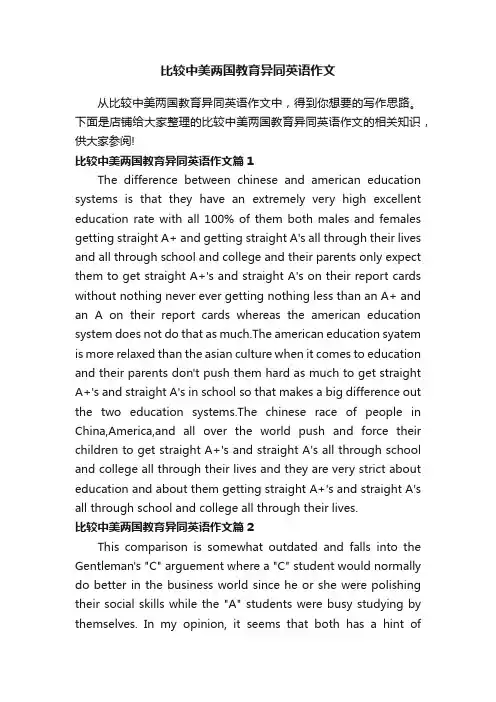
比较中美两国教育异同英语作文从比较中美两国教育异同英语作文中,得到你想要的写作思路。
下面是店铺给大家整理的比较中美两国教育异同英语作文的相关知识,供大家参阅!比较中美两国教育异同英语作文篇1The difference between chinese and american education systems is that they have an extremely very high excellent education rate with all 100% of them both males and females getting straight A+ and getting straight A's all through their lives and all through school and college and their parents only expect them to get straight A+'s and straight A's on their report cards without nothing never ever getting nothing less than an A+ and an A on their report cards whereas the american education system does not do that as much.The american education syatem is more relaxed than the asian culture when it comes to education and their parents don't push them hard as much to get straight A+'s and straight A's in school so that makes a big difference out the two education systems.The chinese race of people in China,America,and all over the world push and force their children to get straight A+'s and straight A's all through school and college all through their lives and they are very strict about education and about them getting straight A+'s and straight A's all through school and college all through their lives.比较中美两国教育异同英语作文篇2This comparison is somewhat outdated and falls into the Gentleman's "C" arguement where a "C" student would normally do better in the business world since he or she were polishing their social skills while the "A" students were busy studying by themselves. In my opinion, it seems that both has a hint ofarrogance steming from a position of weakness. I have first hand knowledge that the public education system in the US has severly deteriorated with this "No Child Left Behind" program. Instead of trying to bring up the few slower students, the country has decided to dumb down the course ciriculum so everyone passes.I believe that true learning can only be achieved by repetition for most of us save the very gifted. And if you want to call it "by rote", so be it. Why do you think that most students that recieve a perfect SAT score are Asians that are first or second generation? The Asian student population does so well acadenically, that many top US universities limit the number that they will accept each year. The same thing was said about the Japanese education system and now look at them, I don't think you can say they are not innovative. China is going through it's industrial revelolution and is well recognized as being able to "copy" anything. Buit give them 10 years or so, I know they will be a world power and innovator. Unfortunately, I can't say the same thing about the US. 比较中美两国教育异同英语作文篇3Education is one of the most important things during our life.I know the difference between Chinese education and American education. American high education is the best in the world, but when we talk about the basic education, most people will have different bifurcation. However, it is allowed in U.S. Americans think calculators go fast and are correct. So, when both students have an exam, then Chinese are better than American students. But when both students use some information tools, then Americans are really better then Chinese student. All appearance, Chinese students are better than American students when they manage and exploit cerebra, but when we compare how to use different information or how tospread cerebra, the American students are better than Chinese students. When we compare the Chinese basic education with America’s, then most people’s opinion are that Chinese education is for foundation education, and American education is for the cultivation of students’ creativity. In China, “seventy three percent people agree, and twenty four percent disagree with this. Also another three percent think Chinese education is foundation education, but student may be not learning much, while American education is for cultivating students’ creativity, but it can let students learn more.” China and America have totally different tradition and exams. Chinese education focuses on the knowledge to accumulate and indoctrinate, on how students use and manage the knowledge they learned in school, and on how to understand the knowledge system and structure. Reversely, American care more about how students use knowledge in society. It lets student challenge the knowledge, animadvert ideas, and focus on, exploit or create knowledge. These two types of attitude about education show us the different ways to understand knowledge, and also to show two countries with different education opinions. “In China, when comparing the education, sixty percent people think the best education model is uniting both advantages. It lets students have very good foundation education and good creativity. Sixty five percent disagree. Another thirty three people think, because the two types of education come from different culture, tradition and society background, it is really hard to combine.” The difference between China and America is mostly an education and knowledge difference. Such as, what is basic foundation education? We can have an example in math. In Chinese education, Chinese think it is basic to have calculation skills soeverybody has to remember the entire concept. So, from elementary school to high school you are not allowed to use a calculator. American education focuses on improve student assuredness, self-determination, independence, and Chinese education focuses on strictness and preciseness. Good foundation education can improve creation; also it can improve stud ent’s thinking. Good preciseness can improve comprehensive thinking. Also, could be an enemy to thinking. Education is culture, and different educations show different societies’ culture; the good American education system may not be good for Chinese society. So, different education has to follow the society background. Because different society backgrounds and different culture helps humans create a different country in the world, American education should be following the American’s culture. Also, Chinese education has to follow Chinese culture. A good education model for China is very important to the learning process, and also is very hard. Anyway, we only need modern education which is internationalization education system and localization education systems unite each other. That is going to improve our education skills.比较中美两国教育异同英语作文篇4Quantities of lessons per day: Each Chinese teacher teaches only one subject while each US teacher teaches all subjects. Each Chinese teacher teaches two periods every day while each American teacher teaches at least five periods every day.Sizes of classes: Chinese schools have larger classes of more than 50 students each while American schools have smaller classes of around 25. So, the final result is that each Chinese teacher teaches the same quantity of students as his/herAmerican counterpart.Efficiency in classroom activities: Chinese classes are much bigger, and fortunately, students are well trained and more efficient in following the teachers' advice in participate in certain activities. Americans classes are smaller, but their students will waste some time in adjusting themselves according to their teachers' suggestions.Foreign languages: Chinese schools usually have English as their foreign language, and Russian and Japanese are only taught in some schools in the north of China and some top foreign language schools (e.g. German, French and Japanese are taught in Nanjing Foreign Language School) whereas American schools may teach French, German, Italian, Spanish, Japanese, Chinese, etc. as their foreign languages.Test-Oriented Education: Chinese schools are criticized for providing test-oriented education, the result of which is producing students of less ability. We are trying a lot to adapt our schools to quality-oriented education. But Americans say that they are learning from us in preparing their students for exams. Maybe, the two extremes of education are going together. The two peoples are "making two ends meet".Quantities of feedback: Each Chinese teacher marks layers of layers of students' exercises every day and give immediate feedback to students while an American teacher leaves all the work to their parents.Observing classes: Chinese teachers regularly go to other classrooms to observe other how teachers do their work in order to make their own work more efficient while American teachers never have such time and practice.Office work: Chinese teachers of the same field have thesame department office for their office work. So they often do their team work in discussing what to be taught, how to teach it, etc. American teachers have their own small offices respectively. They do not often meet except the half-an-hour lunchtime at the canteen every day. Each teacher does everything according his/her individuality and experience.Weekly Conferences: Chinese teachers are assembled by headmasters for usual weekly conferences. But American teachers Very Seldom have meetings. Those seldom meetings (might be at the beginning and end of each semester) are the rare chances for their teachers to meet and exchange info.Political Study: Chinese teachers spend two hours on Wednesday afternoon for political study but American teachers do not do so. Such political study consists of reading CPC documents and raise teachers' morale and vitality by encouraging words. Sometimes such conferences may contain criticism for those who are not devoted and who do paid after-school tutoring work at home. American teachers are busy and have successfully ranked themselves in the middle class, so they do not have to do paid tutoring work.Selective Schools: Chinese students often select their schools by paying a sum of money the school, whether the school is public or private. For most public schools, the sum is 15000 RMB for a three-year period in Junior High School in Nanjing. Seldom do Americans select their schools and public schools are not selective. If they do select, they have to pay twice--once they pay taxes, the second time they pay school tuition. For an ordinary private school in New York City, the tuition might be only 2000 USD per year. But for better private schools, the tuition charge might rise 15000 USD or even to 20000 USD per year.School systems: China has a system of junior and senior high schools, each period being 3 years. America has a system of middle school and high school, the former being 3 years (Year 6~8) and the latter being 4 years (Years 9~12). So their elementary schools range from Year 1 to Year 5.Bureau of Education: In China, we have the Bureau of Education as governmental organs of different levels of administration. But in America, such an organ never exists. So their schools are run by non-governmental fundations.Finance: Public schools in China are financed by governments of different levels. Headmasters and teachers usually do not have worry about their salaries. American schools are financed by fundations and they do not worry about salaries either.Teachers' education background: Chinese high-school teachers now have better and better education background: in the past, they might have associate degrees (i.e. they were graduates from junior teachers' colleges), but now they are usually bachelor's degree holders (i.e. they have graduated from teachers' colleges or normal universities). Yet, very few have master's degrees. American teachers at least have bachelor's degrees, and oftentimes they have master's degrees.Teacher's professional development: Teachers in China can study as part-time students in normal universities, usually at the weekends or during vocations, to achieve a better degrees. Even some can leave their temporarily (say, for 2 years) to study in normal universities to upgrade their degrees. They also have other forms of on-the-job training by governmental organs and observing other teachers teaching, etc. American teachers can go to universities after they work for a certain period in a school, say,4 years.。
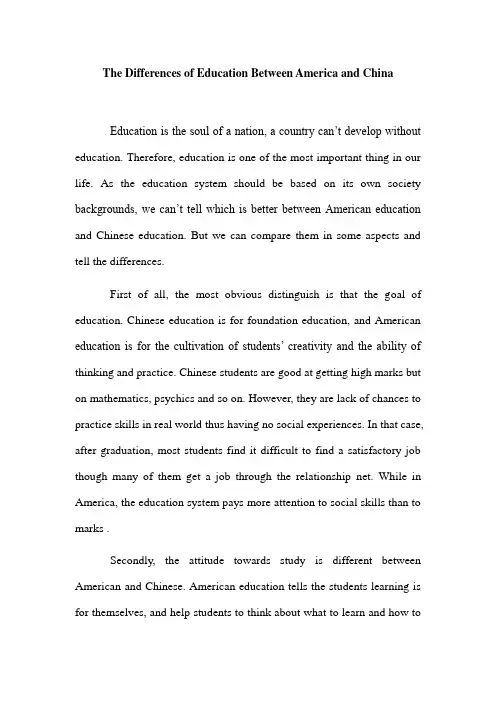
The Differences of Education Between America and ChinaEducation is the soul of a nation, a country can’t develop without education. Therefore, education is one of the most important thing in our life. As the education system should be based on its own society backgrounds, we can’t tell which is better between American education and Chinese education. But we can compare them in some aspects and tell the differences.First of all, the most obvious distinguish is that the goal of education. Chinese education is for foundation education, and American education is for the cultivation of students’ creativity and the ability of thinking and practice. Chinese students are good at getting high marks but on mathematics, psychics and so on. However, they are lack of chances to practice skills in real world thus having no social experiences. In that case, after graduation, most students find it difficult to find a satisfactory job though many of them get a job through the relationship net. While in America, the education system pays more attention to social skills than to marks .Secondly, the attitude towards study is different between American and Chinese. American education tells the students learning is for themselves, and help students to think about what to learn and how tolearn, so American students study actively, flexibly and creatively. Meanwhile, Chinese education has many prescription about what to learn, when to learn, and how to learn. In China, many parents only care about whether the children have a promising future, a good job, a good life or not and the teachers care no more than the high marks.What’s more, China and America have totally different tradition and exams. Chinese education focuses on the knowledge to accumulate and indoctrinate, on how students use and manage the knowledge they learned in school, and on how to understand the knowledge system and structure. Reversibly, American care more about how students use knowledge in society. It lets student challenge the knowledge, animadvert ideas, and focus on, exploit or create knowledge. These two types of attitude about education show us the different ways to understand knowledge, and also to show two countries with different education opinions.The last but not the least, as to the teaching methods, the two system have done a totally different. For school education, Chinese teachers tend to explain the known knowledge such as formulas, academic theories, and that, on the contrary, overseas teachers are more likely to enlighten students and guide them to probe into the unknowntheories. Chinese teachers often give students a conclusion and it is the best if the students have no problems. But American teachers are good at enlightening the students to find more problems. For family education, in Chinese family , affected by Chinese traditional culture , parents educate children by “ control ” and “ seal ” type . Most American parents emphasize more to train their children’s ability of independence once they are born because they think that children should form a self-supporting will and the capacity to live independently since their childhood .This is the differences between education of two countries in my eye.。
中美高等教育对比The-Diff...AbstractEducation has become a symbol of the national power. Every year a great number of students from all over the world come to American for studying. On the contrary, China as an ancient country civilization with over five thousand years, only have several famous universities. This paper aims to study the difference of higher education between China and America and find out the merit of American education. Then take the essence and discard the dregs to improve the quality of our own education.Key words: Higher Education; Difference; China; AmericanIntroductionHigher education is an educational level that follows a completion of a school providing a secondary education, such as a high school, secondary school, or a gymnasium. Higher education is normally taken to include undergraduate and postgraduate education vocational education and training. Colleges, universities and institutes of technology are the main institutions that provide higher education.In many developed countries, a high proportion of the population, now enter higher education at some time in their lives. Higher education is therefore very important to national economic, both as a significant industry in its own right and as a source of trained and educated personnel for the rest of the economy. College educated workers command a significant wage premium and are much less likely to become unemployed than less educated workers.The American university has been considered as models bythe world, although it only has a history of 300 years. Every year thousands of students from all over the world come to American for studying, including a large number of Chinese excellent students. With the development of economic, China also attracts a lot of oversea students in recent years, but there still are many differences on higher education between China and America. As a result, we should learn from America and make improvement in our education.I The Differences of Higher Education between China and AmericaFirstly, they are different in teaching methods.In American, inspiring students is great important for teaching. In classroom, teachers will specially put forward some inspiring questions for students. In such a teaching mode, students in the classroom have a higher degree of freedom, and they can be ready to make their own doubt for teachers which made the teaching atmosphere lively and vivid. This method of teaching helps students develop the ability of independent thinking and solving problem. However, China’s higher education pays more attention to the systematic study. When teaching the curriculum, teachers should follow in accordance with certain teaching programs. Although students have certain interactive questions, this kind of questions tend to be concentrated after the class, rather than in the classroom. It is the main mode that class is taught by teachers and students just listen to the records. This approach is conductive to help the students learn systemic knowledge, and they have less sense of innovation.Secondly, they have differences in the dependence of students. In America, college students are likely to be more independent of their parents. Students often make decisions bythemselves, no matter on studying and live. And students are often expected, as part of learning to be an adult, to pay for part or all the costs of college by themselves. On the other hand, pa rents also give more freedom for children to the best of their abilities. Some American college students thrive in this new found freedom, and some flounder. Many grow up quickly during college, while others fail and leave college to find full-time jobs. In China, college students are likely to be their parents’ only child—the foc us of family pride, concern, and hope. Their parents’ work hard to help them succeed, including helping them study for the dreaded college entrance exams. And parents try their best to teach traditional Confucian values of honoring family, teacher, and education and the modern realities of rapidly expanding commerce and technology.Thirdly, they have different targets. In American, every university has its reasons to exist, no matter how small it is. And each university knows what their target is. For example, the economic institute of Stanford university has three goals for undergraduate. There is no doubt the number of universities in China is increasing butmost university don’t know why it should be established and exists. Just because China has a large population, more universities can let more students go to the university. In addition, the development of Chinese universities behaves a bit impulsive, for example, many universities are seeking for certain “world rankings” but overlook the formal developm ent of themselves. And most of students choose to go to university is to get a diploma which can help them find a job easily.II The Reasons for the DifferencesChina and America has different social environment. Americais open social. The society’s openn ess urges the American college to abandon the old education on thought which European traditional university sticks to, adopts open policy to absorb all advantages from other countries and establishes diverse and open education control system which emphasizes the actual effects. America is the biggest immigrant country which has very strong containing nature in the culture. American economy emphasizes on the practical value, matter reward as well as individual value realization with fast development, rich material life, strong material idea and etc. The American advocates the independent way of life and work. The American owns full creative humanities spirit, the innovation is the forever subject in their brains. They pursue the high-tech and prefer to compete.Contrast with young American, China is the great nation with glorious history and cultural traditions. The Chinese people have the excellent moral of modesty, rigorous and implicit, but also have been over cautious and conservative. Through Chinese economy and technology is quite backward, it has very strong potential development. Therefore, China implements the policy of opening up, abundantly absorbs the benefit and enriches itself.Besides, Education is a cultural phenomenon, different education response to a different culture. So we can see the cultural difference in the view of higher education. From ancient on, Chinese people are always very conservative, which result in they lack of spirit of adventure and innovative conscious. As a result, the student in theclassroom is not very active. By contrast, America is a nation of immigrants with a short history. With the influence of multi culture and different values, it is easy for them to be more livelyand free.III Enlightenment from the Concept of American Higher Education Nowadays, China’s higher education is shift from the examination-oriented education to quality education. Indeed what kind of education principles and practices to choose is not only related to quality of education, but related to the future of the Chinese nation and all young students’life development. The reform of higher education should respect history and national conditions with compatible absorption and innovation. Here is some enlightenment from the concept of American higher education.Firstly, teaching management should achieve the reunification of system and flexibility. Teaching management system is a set of regulations and criterions to ensure the normal functioning of teaching and extracurricular life. In the development of teaching management system, standard and uniformity nature of the system if often focused, while the humanities, reasonableness and flexibility is consider insufficiently.Secondly, students’ sense of participation should be fully prominent in teaching practice. The stress of individualized education is to awaken and mobilize students’main principle, promote students’ initiative and creativity. It not only emphasizes the lead role of teachers in the process of teaching, but also give the main role to students in the process of learning. Therefore, teaching should focus on taking individualized teaching methods, strategies and techniques, widely apply the science teaching methods.Furthermore, our education system should have appropriately change. Every university should adjust its directionand position in a timely manner with the social development, so that it keep pace with the times, and successfully transform the university into a higher level.ConclusionFrom what has mentioned above we know the differences of higher education between America and China as well as its reason. There is no point saying which kind of education is superior. We should improve ourselves continuously only if we could find out our weaknesses in this comparison and learn from the best. American higher education is the heaven for the students to learn what they like and what they need actually.Higher education in China is continuously growing, changing and developing. Higher education in China has played a significant part in economic growth, scientific progress and social development in the country by bringing up large scale of advanced talents and experts for the construction of socialist modernization. At the end of the paper lists some enlightenment from the concept of American higher education. If we can follow these changes, Chinese higher education will go to a bright future and American also can get something they lack of from our higher education.。
The difference between Chinese education and American educationA growing number of Chinese student are tend to study abroad. But some Chinese parents let their children study at local schools because they think Chinese elementary education is the best among the world. So is oversea-study beneficial to us? Let’s compare the difference between Chinese education and American education.Chinese and American education has different aims. Chinese education has the intention to teach students how to take an exam. There is more demonstration than experiments in class. Chinese student always just take notes and memorize. Also, students believe studying is just the tool to gain status, good jobs, money and fame. Most of them do not like studying and think they are forced to study. On the contrary, American education does not focus on exams or tests. They are more likely to educate a leader or a scientist, not an exam-preparer. To them, creativeness, leadership, and cooperation skills are far more important than test scores or so-called ‘basic knowledge’. Thus no wonder why there is a saying ‘American develop leaders, but Chinese develop bureaucrats.’American students take part in extracurricular activities instead of suffering from much homework. Most of them join those kinds of activities spontaneously. Organizing, developing and collecting funds are all done by themselves. For instance, an 8-year-old boy may help his neighbors wash clothes for 8 dollars per piece. Or he may play musical instrument for others and use the money he earns as funds to organize other activities. Nevertheless, not all the extracurricular activities are well-paid; most of them are volunteer works. There are a wide variety of ways for American students to get in touch with the society. They believe that education is a part of life, not just a part of school.Now let’s move to the curriculum. Here’s the curriculum in Phillips Exeter Academy, a private high school in America. There are nearly 400 sorts of courses including modern language, classical language, English, history, religion, anthropology, psychology, economics, art, drama, music and physical education. Surprisingly, their math courses are also various. Many Chinese believe that American’s math is terribly bad. But they have linear algebra, calculus and statistics which are advanced courses. Compare with Chinese schools, you can easily get answer why Chinese students can get gold medal in the Math Olympics Competition, but Nobel Prize winner are often American.I don’t think we should be proud of our exam-based education system. But we cannot abrogate exams, because it is the only way to keep a relative justice. Our education system depends on our political system. Without free speech and non-commercial academic spirit, we can hardly enhance our education. There is a long way to go.。
中美高中教育差异英语作文Differences Between Chinese and American High School Education。
High school education is an important stage in the academic journey of students all around the world. However, the approach to high school education in China and America differs significantly. In this essay, we will explore the differences between Chinese and American high school education.First and foremost, one of the key differences between Chinese and American high school education lies in the teaching methods. In China, the education system is largely based on rote learning and memorization. Students are expected to memorize vast amounts of information and regurgitate it during exams. On the other hand, in America, the emphasis is on critical thinking, creativity, and problem-solving skills. Teachers encourage students tothink outside the box, ask questions, and engage indiscussions.Another significant difference between Chinese and American high school education is the level of competition. In China, there is intense competition among students to excel academically and secure a spot in a prestigious university. This pressure often leads to high levels of stress and anxiety among students. In contrast, in America, the focus is more on individual growth and development. Students are encouraged to pursue their interests and passions, rather than just focusing on academic achievements.Furthermore, the structure of the high schoolcurriculum also differs between China and America. In China, the curriculum is standardized and students are required to study a set number of subjects. There is little room for customization or flexibility. In America, on the other hand, students have more freedom to choose their courses andtailor their education to their interests and career goals. This allows students to explore a wide range of subjectsand develop a well-rounded education.In addition, extracurricular activities play adifferent role in high school education in China and America. In China, extracurricular activities are often seen as a distraction from academics and are not given much importance. In America, however, extracurricular activities are an integral part of the high school experience. Students are encouraged to participate in sports, clubs, and community service activities to develop leadership skills, teamwork, and social skills.In conclusion, Chinese and American high school education have their own strengths and weaknesses. While the Chinese education system emphasizes academic excellence and discipline, the American education system focuses on creativity and individuality. Both systems have their merits, and there is much that each can learn from the other. Ultimately, the goal of high school education should be to prepare students for success in the ever-changing global economy.。
中西教育差异:探索中国与美国教育方式的对比In the vast landscape of global education, China and the United States occupy two distinct and intriguing peaks. Each nation's educational system is shaped by its unique history, culture, and societal values, resulting in significant differences that impact students' learning experiences and outcomes. This essay aims to delve into these differences, highlighting the varying approaches and outcomes of education in China and the United States.**Curriculum Design and Content**In China, the curriculum tends to be more standardized and focused on core subjects such as math, science, and language arts. This approach ensures that students across the country receive a consistent and comprehensive education, emphasizing depth and mastery of fundamental concepts. By contrast, the American education system offers a more diverse and flexible curriculum, allowing students to explore a wider range of subjects and pursue their interests. This approach cultivates creativity and encourages students to think outside the box.**Teaching Methods and Classroom Dynamics**Chinese classrooms often emphasize discipline and rote learning, with teachers playing a more authoritative role. This approach fosters a culture of respect and obedience, but it can also limit students' autonomy and creativity. In contrast, American classrooms tend to be more informal and interactive, with teachers serving as facilitators rather than authorities. This approach encourages active participation and critical thinking, fostering a more dynamic and innovative learning environment.**Assessment and Evaluation**Assessment in Chinese education is typically based on exams and homework, with a strong emphasis on grades and academic achievement. This system rewards consistency and mastery of content but can sometimes lead to excessive stress and a narrow focus on grades rather than learning. By contrast, American education evaluates students more comprehensively, considering a range of factors such as participation, creativity, and critical thinking. This approach recognizes the value of diverse skills andperspectives, but it can also be more subjective and less consistent.**The Role of Parents and Society**In China, parents and society place a high value on education, often expecting students to excel academically. This pressure can drive students to achieve, but it can also lead to feelings of anxiety and inadequacy. In the United States, while education is still highly valued, there is a greater emphasis on personal growth and development. Parents and society tend to be more supportive and encouraging, fostering a more positive and inclusive learning environment.**Conclusion**The differences between Chinese and American education systems are numerous and complex, reflecting the distinct cultural and societal values of each nation. While there are advantages and disadvantages to both approaches, it is important to recognize that education is not a one-size-fits-all process. Instead, it should be tailored to the needs and aspirations of individual students, allowing themto reach their full potential regardless of their background or location.**中西教育差异:探索中国与美国教育方式的对比** 在全球教育的广阔天地中,中国和美国各自占据着独特且引人注目的高峰。